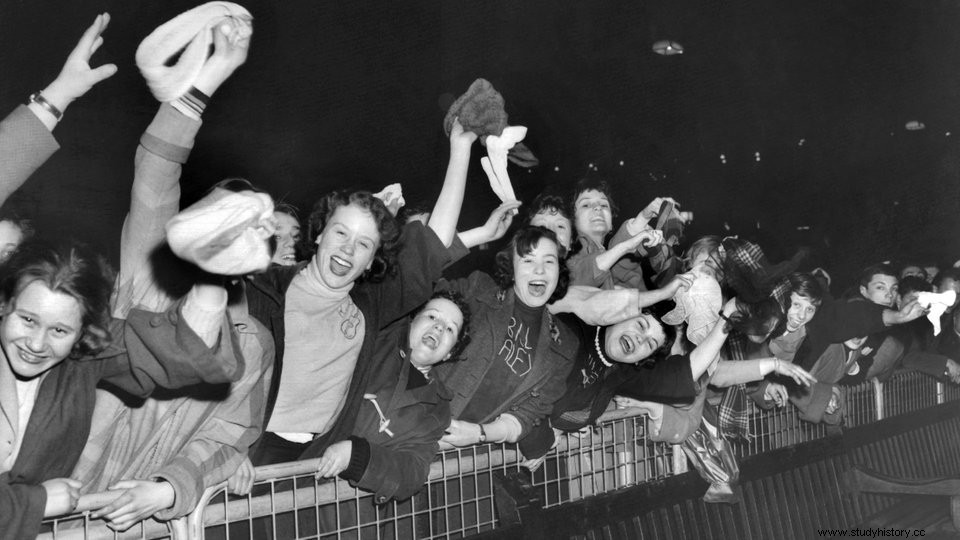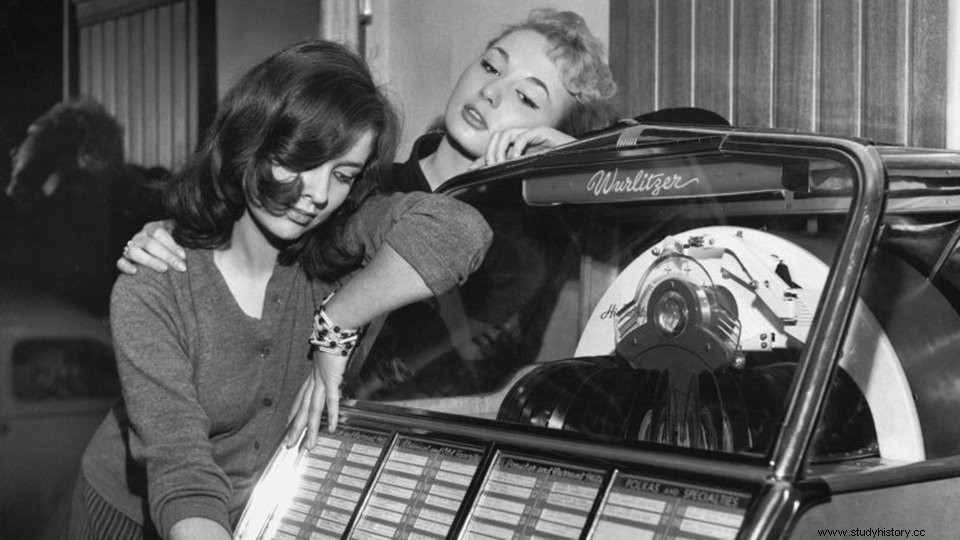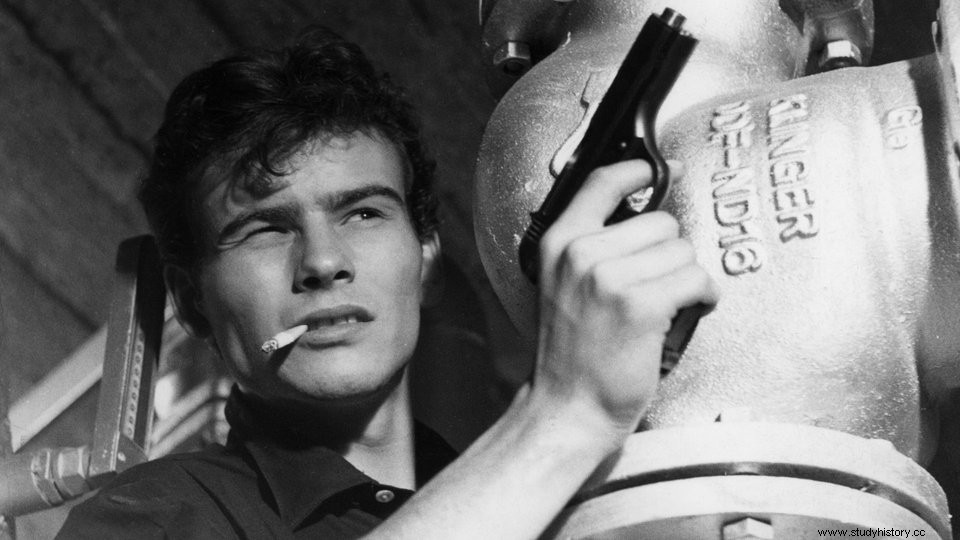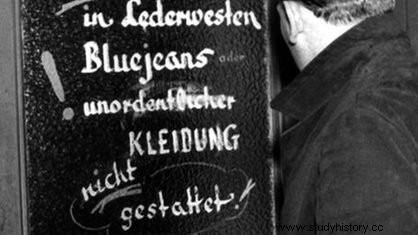In the 1950s things started to pick up again in Germany:wages rose, working hours fell and young Germans became more relaxed. They were the first to establish their own visible youth culture in the Federal Republic.
Young teenagers
The provocative demeanor of the hooligans quickly became a symbol for an entire generation. With the cigarette in their mouth, the fashionable leather jacket and the loudly rattling moped, they shocked the good German citizens in the 1950s. No wonder, since in 1956 sensation-hungry journalists reported almost daily about hooligans on the streets.
If you believe the press, a real hooligan just knew how to use force and slouch around uselessly. Anyone who heard German hits had no place in a clique of hooligans, because hooligans were enthusiastic about everything that came from America. And that was mostly rock 'n' roll.
It was mainly young, working-class men who were attracted to the movement - although far fewer youth belonged to the hooligan than many believed.
Only about five percent of the then 14 to 19-year-olds said in later years that they were teenagers. There were certainly many more who sympathized with the rebellious attitude of their peers.
Existentialists with philosophical idols
However, this was hardly the case with the youthful existentialists. Many "Exis" despised the aggressive demeanor of the hooligans, because in their own environment things were much more civilized.
The "Exis" were taught by high school teachers in the mornings and spent the evenings in smoky jazz clubs. The French philosophers Jean-Paul Sartre and Albert Camus were among her intellectual role models. Black stockings, black pants and black turtleneck sweaters set them apart from the other youth groups.

Young people are waiting to be admitted to the rock'n'roll concert
Fashion and cosmetics for girls
Fight or hang out in jazz clubs? Most of the girls did not find this leisure program very attractive and so they rarely roamed the streets with hooligans and existentialists. They benefited all the more from the emergence of their own teenage culture.
Teenagers now dressed smartly and stylishly, danced body-hugging and took advantage of the wide range of leisure activities of the late 1950s with friends of the same age. For them, being young was fun - and without any political defiance
The fashion and entertainment industry quickly discovered the adapted young people as their own target group. Teenage cosmetics and teenage fashion were soon in every shop window.
Word got around about what was trendy at the time, also because young people had their own mouthpiece from 1956:the youth magazine "Bravo".
Rock'n'Roll, rampage and love
Rock 'n' roll gave the youth of the 1950s their own voice. And that almost everywhere in the western world. At the latest since Bill Haley's "Rock around the clock" the German adolescents had been infected with the new musical virus.
"One, two, three o'clock, four o'clock, rock." Bill Haley's pounding and unleashing music did not fascinate the young audience without consequences:during Bill Haley's tour of Germany, youthful ecstasy turned into wild aggression. In Berlin, Hamburg, Essen and Stuttgart, fans dismantled the interior of the concert halls.

The jukebox also played rock'n'roll
Rock'n'Roll became the soundtrack of a new attitude towards life - and street battles with the police were also part of this attitude towards life. Between 1956 and 1958 alone there were 350 major riots in almost all major West German cities.
Rock'n'Roll not only accompanied mass brawls, but also the first attempts to get close to love-mad young people on the dance floor. Those who danced rock'n'roll didn't necessarily stick to the painstakingly rehearsed step combinations, but rather let their pelvis gyrate lasciviously - following the example of Elvis Presley, who had risen to become the undisputed star of the rock'n'roll scene since 1957.
Elvis hits were also a must during the ride on the fair's "Knutschraupe". The owners of the chassis quickly found out that signs like "Schlager from the USA" or "Meeting point for Rock'n'Roll fans" became a crowd puller.
Of course, the rush to the caterpillar had another reason:the caterpillar was the only fairground attraction that made the drivers disappear behind a tarpaulin for a few precious seconds. Enough time for young people in love to exchange secret kisses.
The film industry is discovering youth
The young people of the 1950s longed for new role models - and not only found them in music. With the film "Because They Don't Know What They Are Doing" the American film industry met the taste of adolescents.
And that was no coincidence:the film's director, Nicholas Ray, had researched the archives of the Youth Authority to present a realistic picture of post-war youth. The result was a film about misunderstood, rebellious young people and life-threatening dares.
The adolescents recognized themselves in the film. And so it was no wonder that leading actor James Dean became the idol of a whole generation. The young people wanted to be like him:uncompromising, casual, with a hard shell but a soft core.
When the film was released in German cinemas in 1956, the fans eagerly awaited the decisive scene:Two cars next to each other let their engines roar. A test of courage is pending. Full throttle James Dean races towards the cliffs, because he's really no coward.
At the last second, the screen hero throws himself out of the moving car and thus escapes certain death. In reality, James Dean was less fortunate:when the film was released in German cinemas, Dean was already dead - died in a car accident.

A cult film with Horst Buchholz
The American, who died young, became a myth among young West Germans. But local actors like the young Horst Buchholz also conquered the hearts of the adolescents.
Horst Buchholz made his breakthrough in 1956 with the film "Die Halbstarken". The film was very much in line with young people's tastes, because it deals with conflicts with authoritarian parents, a gang of thugs, casual clothes and a youthful hero.
Youth fashion and hairstyles
"Only put on the flat shoes, because you can dance better with them, the pullovers blue and yellow and red, and the new petticoat with the skirt," teenage star Conny Froboess trilled happily in 1958. Fashion and hairstyles became increasingly important for young people in the 1950s.
Juveniles, "exis" and teenagers fought bitter fights with their parents about their clothes. For the first time there was a separate youth fashion and the adolescents were determined to live out their fashionable style even against the will of their parents.

Not always welcome:Jeans and leather jackets
To the dismay of their fathers, young men said goodbye to short military hairstyles and instead grew a ducktail, i.e. a quiff that was brushed upwards with as much pomade as possible. The girls' tightly braided pigtails gave way to bobbing ponytails or loose, teased hair.
Not only young men attracted attention with jeans, leather jackets and pointed leather ankle boots. A revolution was also brewing in girls' fashion. When the first young women in trousers entered the school, there was a hail of reprimands and outcry.
In vain, however:soon the trousers for teenagers could be conveniently ordered from the mail-order catalogue. The fashion industry had read the signs of the times, and what was scandalous in the mid-1950s was already normal by the end of the decade. At least the youth won the clothing battle.
